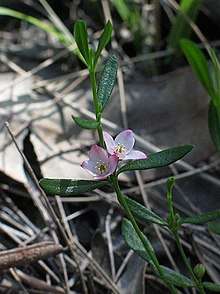Boronia polygalifolia
Boronia polygalifolia, commonly known as dwarf boronia,[2] milkwort-leaved boronia[3] or milkwort boronia,[4] is a plant in the citrus family Rutaceae and is endemic to eastern Australia. It is a low-lying shrub with simple leaves and white or pink flowers arranged singly or in groups of up to three in leaf axils.
| Dwarf boronia | |
|---|---|
 | |
| Scientific classification | |
| Kingdom: | Plantae |
| Clade: | Tracheophytes |
| Clade: | Angiosperms |
| Clade: | Eudicots |
| Clade: | Rosids |
| Order: | Sapindales |
| Family: | Rutaceae |
| Genus: | Boronia |
| Species: | B. polygalifolia |
| Binomial name | |
| Boronia polygalifolia | |
| Synonyms[1] | |
| |
Description
Boronia polygalifolia is a low-lying, spreading shrub that typically grows to a height of about 0.3 m (0.98 ft) with its branches also about 0.3 m (0.98 ft) long. The plant is glabrous, apart from the flowers . The leaves are simple, usually sessile, linear to elliptic, 6–30 mm (0.24–1.18 in) long and 1–6 mm (0.039–0.236 in) wide with the edges down-curved or rolled under. There is usually only one, but sometimes up to three flowers arranged in groups in the leaf axils on a pedicel 1–11 mm (0.039–0.433 in) long. The four sepals are egg-shaped to triangular, 1.5–2 mm (0.059–0.079 in) long, 1–1.5 mm (0.039–0.059 in) long and glabrous. The four petals are pink or white, 4.5–6.5 mm (0.18–0.26 in) long with their bases overlapping. The eight stamens have hairy edges. Flowering mainly occurs from September to January and the fruit is a glabrous capsule 4–5 mm (0.16–0.20 in) long.[2][3][4][5]
Taxonomy and naming
Boronia polygalifolia was first formally described in 1798 by James Edward Smith who published the description in his book ''Tracts relating to natural history.[6][7] The specific epithet (polygalifolia) is a reference to the similarity of the leaves of this species to those in the genus Polygala.[5]
Distribution and habitat
Dwarf boronia grows in open forest, woodland and heath between the Blackdown Tableland and Kroombit Tops in Queensland and Moruya and Geehi in New South Wales. A single specimen has been recorded in eastern Victoria.[2][3][4]
References
- "Boronia polygalifolia". Australian Plant Census. Retrieved 14 April 2019.
- Weston, Peter H.; Duretto, Marco F. "Boronia polygalifolia". Royal Botanic Garden Sydney. Retrieved 14 April 2019.
- Duretto, Marco F.; Wilson, Paul G.; Ladiges, Pauline Y. "Boronia polygalifolia". Australian Biological Resources Study, Department of the Environment and Energy, Canberra. Retrieved 14 April 2019.
- Walsh, Neville. "Boronia polygalifolia". Royal Botanic Gardens Victoria. Retrieved 14 April 2019.
- Duretto, Marco F. (1999). "Notes on Boronia (Rutaceae) in eastern and northern Australia" (PDF). Muelleria. 17: 51–53. Retrieved 14 April 2019.
- "Boronia polygalifolia". APNI. Retrieved 14 April 2019.
- Smith, James Edward (1798). Tracts relating to natural history. London. pp. 297–298. Retrieved 12 April 2019.